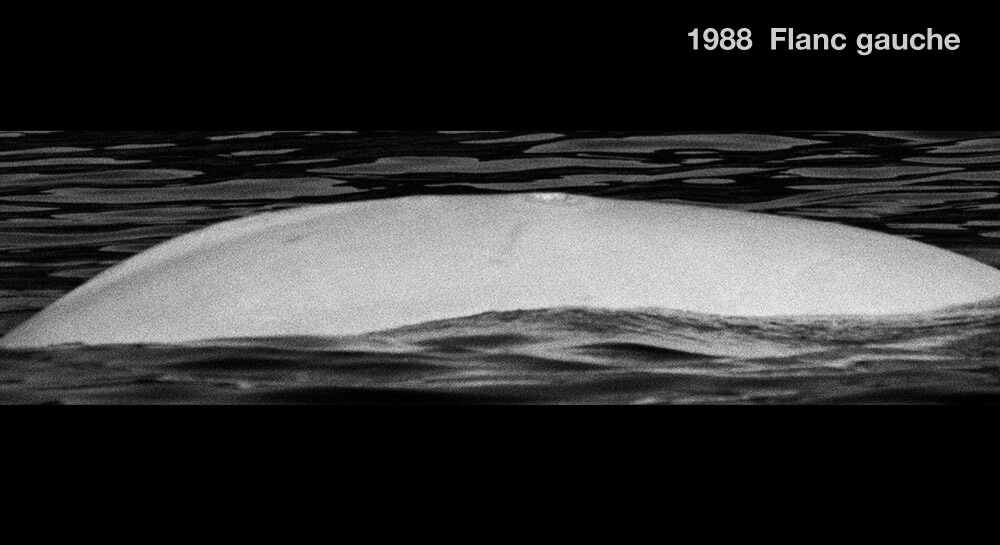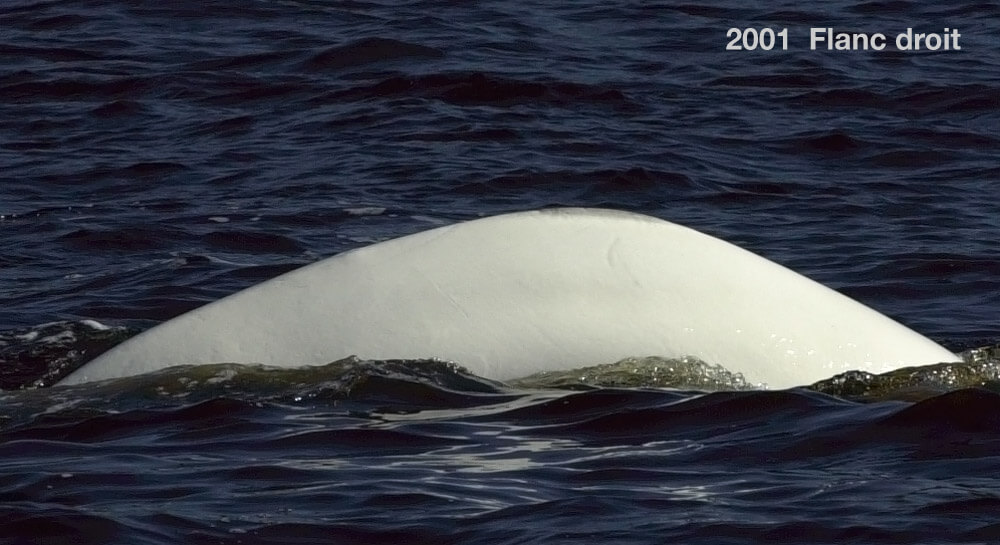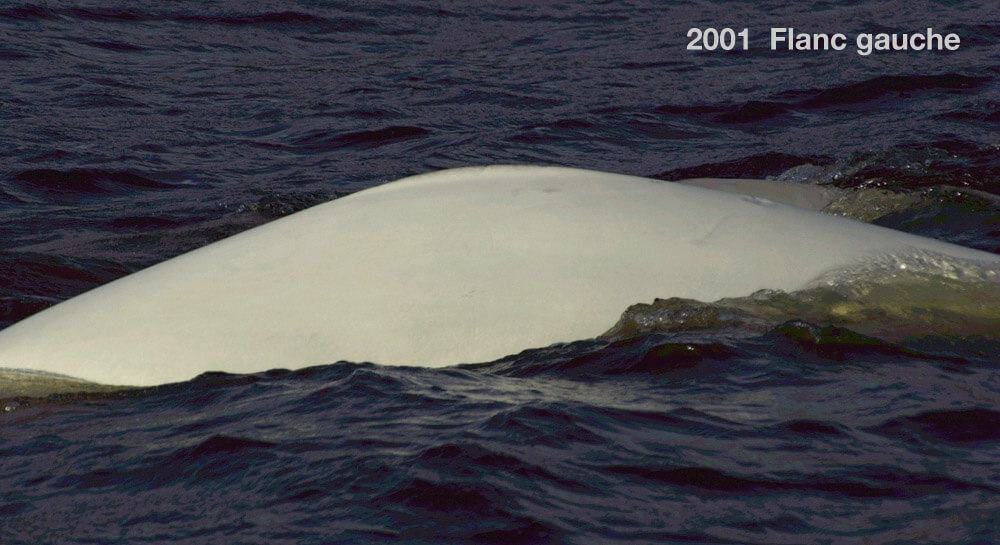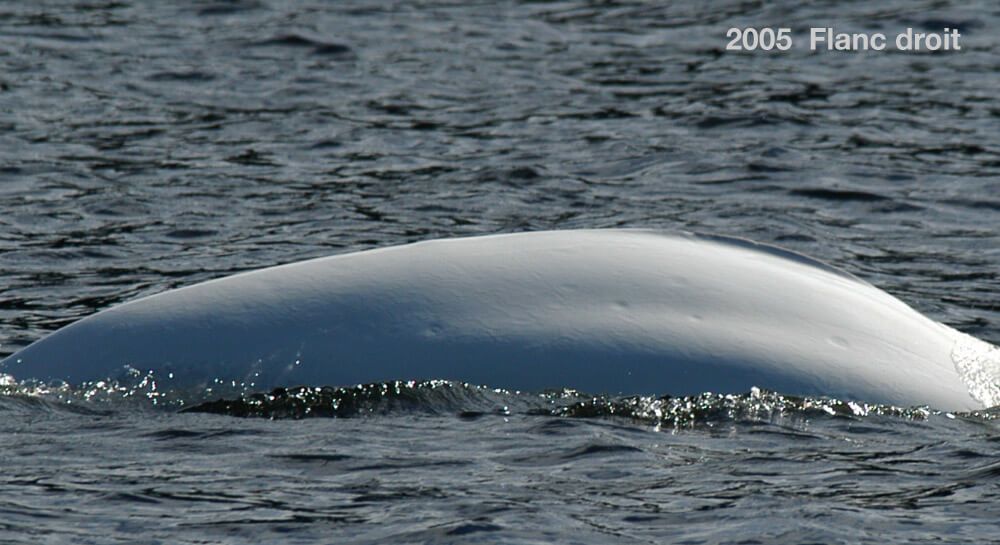Neige
Beluga

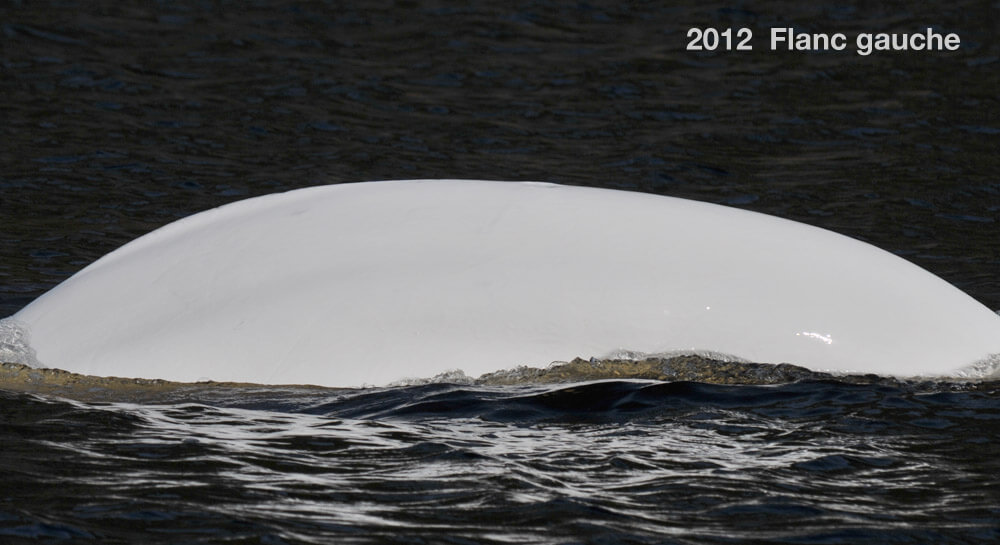
Adopted by the riverside municipalities of the St. Lawrence
-
ID number
DL0259
-
Sex
Presumed female
-
Year of birth
Around 1980
-
Known Since
1988
Distinctive traits
Neige is distinguished by the position and shape of the small scar on her upper flank, behind her dorsal crest. This mark is visible on both sides, but is less pronounced on the right flank.
Life history
Our first encounter with Neige goes back to 1988. At the time, she was still slightly grayish in colour. She turned completely white in the mid-1990s. Belugas fade from gray to white in colour between the ages of 12 and 16. Neige would therefore have been born around 1980.
Her small size, habits and regular presence in herds comprising adults and young suggest that Neige is a female and that she belongs to the Saguenay community. In summer, females form large communities in which they tend to newborns and young. These communities are faithful to traditional territories and exchanges between them are uncommon.
Neige is regularly observed in the company of DL0030 and DL0169, who are also part of the Saguenay community. Associations between females of the same community are generally not very stable. They may vary depending on the females’ reproductive status and whether or not they are pregnant or accompanied by a calf.
Over the years, Neige has regularly been seen accompanied by newborns and very young belugas. It is difficult to establish mother-calf relationships with certainty. Our observations lead us to believe, however, that Neige has already given birth several times. On a single occasion, our observations allowed us to confirm that one of these young was indeed her own.
How Neige’s story unfolds will teach us volumes on the evolution of belugas’ social and reproductive lives. By better understanding how belugas live, we will better be able to protect them.
Observations history in the Estuary
Years in which the animal was not observed Years in which the animal was observed
Latest news
The summer of 2016 – our 32nd season at sea with the belugas – was once again rich in encounters and surprises. Observations include sightings of Neige on at least two occasions. As usual, she was recognized in beluga herds consisting of adults, juveniles and newborns. However, our observations do not allow us to confirm whether or not she was the mother of any of these calves.
September 6, 2016: at Baie Sainte-Marguerite, we spot a herd of about 40 adults and young, including six newborns! This is one of the largest concentrations of calves observed this summer. Neige is there and is swimming with Athéna, one of her regular companions in the Saguenay community.
The animals are making vocalizations galore! Hearing beluga “voices” is not rare, but is always impressive. The beluga’s vocal repertoire is vast, comprising whistles, chattering, squeals and grunts, earning them the nickname “canaries of the sea”.
This summer, we crossed paths with Neige on two occasions. During these encounters she was swimming in close proximity to newborns, though our observations did not allow us to confirm whether or not any of these calves were in fact her own. Below is an account of one of these encounters.
September 17, 2015: we are sailing in the Saguenay Fjord, near Cap de la Boule. Neige is swimming in a small herd of about ten individuals comprising adults and young, including two newborns. The herd is slowly heading up the Fjord. The winds are strong and the animals are swimming against a powerful current. In Neige’s company we spot… surprise: Yogi! Despite its name, Yogi is a female. Although she belongs to the same community as Neige, she is usually seen alone rather than in herds.
On the afternoon, we’re in Baie Sainte-Marguerite with a herd in which females Neige and Pascolio are recognized. Other adults join in. Hyperactive gray-coloured calves chase they prey, possibly eels as far as we can tell! The day ends with a biopsy of one of the belugas and the observation of four calves.
Sponsor
The riverside municipalities of the St. Lawrence Solidary adopted Neige, Nics, Bilou, Cica and Solidaire (2014).
Beauharnois; Bécancour; Candiac; Carleton-sur-Mer; Charlemagne; Chute‐aux‐Outardes; Châteauguay; Contrecoeur; Grande Rivière; La Pocatière; Lanoraie; Les Bergeronnes; Louiseville; Lévis; Matane; Montmagny; Montréal; New-Richmond; Notre-Dame-des-Sept-Douleurs; Percé; Pincourt; Port-Cartier; Québec; Repentigny; Rimouski; Saint-André; Saint-Zotique; Sainte-Anne-de-Sorel; Sainte-Anne-des-Monts; Saint‐Ignace‐de‐Loyola; Saint‐Siméon; Salaberry-de‐Valleyfield; Sept-Iles; Sorel-Tracy; Tadoussac; Varennes
Click on the names below to discover texts, drawings and videos composed by children of participating schools on Facebook as part of the Our Beluga’s Name is… contest.
Neige was named by the special education class of the École Saint-Alexandre in Port-Cartier.
Nics was named by the 5th and 6th grade class of the École Élisabeth Turgeon in Rimouski.
Bilou was named by the 3th grade class of the École de Ste-Thérèse-De-L’Enfant-Jésus in Saint-Jérôme.
Cica was named by the 2th grade class of the École de la Ruche in Lévis.
Solidaire was named by the 5th grade of the École Our Lady of Pompei in Montreal.

